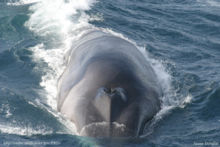Northern fin whale
| Northern fin whale[1] | |
|---|---|

| |

| |
| Size compared to an average human | |
| Scientific classification | |
| Domain: | Eukaryota |
| Kingdom: | Animalia |
| Phylum: | Chordata |
| Class: | Mammalia |
| Order: | Artiodactyla |
| Infraorder: | Cetacea |
| Family: | Balaenopteridae |
| Genus: | Balaenoptera |
| Species: | |
| Subspecies: | B. p. physalus
|
| Trinomial name | |
| Balaenoptera physalus physalus | |
The northern fin whale (Balaenoptera physalus physalus) is a subspecies of fin whale that lives in the North Atlantic Ocean and North Pacific Ocean.[1] It is possible that the population in each ocean represents a separate subspecies. At least one other subspecies of fin whale, the southern fin whale (B. p. quoyi), exists in the southern hemisphere.[1]
Size
Northern fin whales are smaller than their southern hemisphere counterparts, with adult males averaging 18.5 m (61 ft) and adult females 20 m (66 ft).[2] Maximum reported figures are 22.9 m (75 ft) for males and 24.7 m (81 ft) for females in the North Pacific, while the longest reliably measured were 20.8 m (68 ft) and 22.9 m (75 ft) — all were caught off California, the former in the 1920s and the latter in the 1960s.[3] At sexual maturity, males average 16.8–17.6 m (55–58 ft) in the North Atlantic and 17.4–17.7 m (57–58 ft) in the North Pacific, while females average 17.7–19.1 m (58–63 ft) in the North Atlantic and 18.3–18.6 m (60–61 ft) in the North Pacific. At birth, calves are 6.4 m (21 ft) in the North Pacific.[2]
Reproduction
Because of the opposing seasons in each hemisphere, B. p. physalus breeds at a different time of the year than B. p. quoyi. Peak conception for B. p. physalus is December-January, while peak birthing is in November-December — in both the North Atlantic and North Pacific.[2]
References
- ^ a b c "Balaenoptera physalus". Integrated Taxonomic Information System. Retrieved 2012-08-15.
- ^ a b c Evans, Peter G. H. (1987). The Natural History of Whales and Dolphins. Facts on File.
- ^ Clapham; et al. (1997). "Catches of Humpback and Other Whales from Shore Stations at Moss Landing and Trinidad, California, 1919-1926". Mar. Mam. Sci. 13 (3): 368–94. doi:10.1111/j.1748-7692.1997.tb00646.x.
